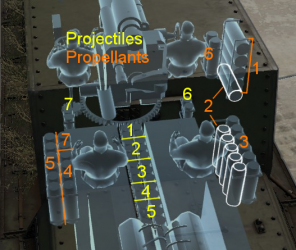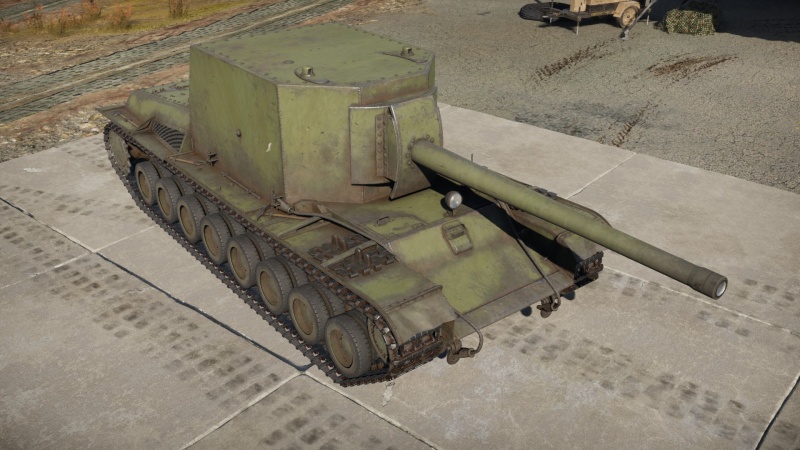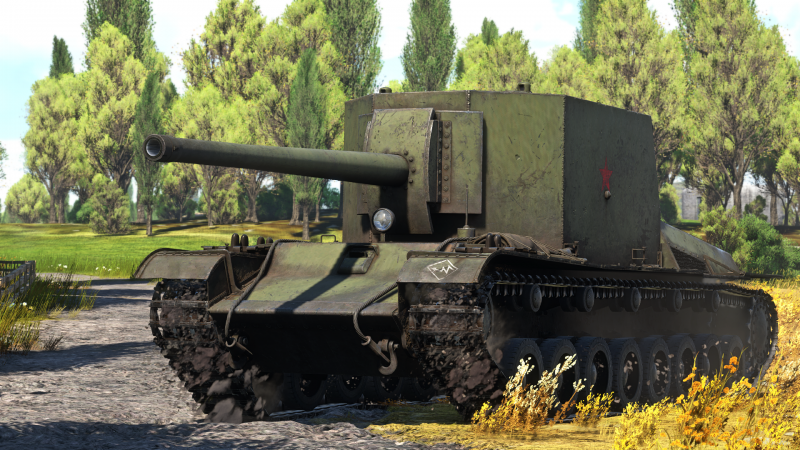SU-100Y
| This page is about the Soviet tank destroyer SU-100Y. For other uses, see SU-100 (Disambiguation). |
Contents
Description
The SU-100Y was a Soviet prototype developed from the chassis of the T-100 heavy tank prototype in the Winter War. The vehicle was intended to fill a similar purpose as that of the KV-2, using its 130mm naval gun to provide support to infantry against fortified positions. The use of a high velocity 152mm gun was also proposed. The tank never made it past a prototype phase, although the single prototype built was reportedly used in the defence of Moscow in 1941. The sole model in existence is currently preserved at the Kubinka Tank Museum.
It was introduced in Update 1.51 "Cold Steel". The SU-100Y is a very heavy tank destroyer with an extremely powerful gun. The tank features mediocre armour at the front, and can be penetrated with ease by most enemies around its BR at close ranges. Its mobility can be considered average at best, reaching it's top speed relatively quickly for a tank of it's size, although the reverse speed is very poor. Its gun is a 130mm B-13 naval gun which uses SAPCBC as its regular ammo. Boasting a large amount of explosive filler and high penetration even at long ranges, the SU-100Y has no trouble destroying enemy tanks.
General info
Survivability and armour
Armour type:
- Rolled homogeneous armour
- Cast homogeneous armour (rear hatch)
| Armour | Front | Sides | Rear | Roof |
|---|---|---|---|---|
| Hull | 60 mm (46°) Front plate 60 mm (71°) Front glacis 25 mm (49,70°) Joint plate 60 mm (49°) Lower glacis |
60 mm Overall 60 mm (27°) Engine side deck |
60 mm (5-14°) | 20 mm Front 20 mm (82°) Rear deck |
| Superstructure | 60 mm Front 50 mm (1-27°) Gun mantlet 60 + 60 mm Gun shield |
60 mm | 60 mm (17°) | 20 mm |
Notes:
- Suspension wheels are 20 mm thick while the tracks are 30 mm thick.
- The protection is only 60 mm thick at its strongest. Weapon calibres exceeding 20 mm can pierce the armour, turning SPAAG into a real threat, if close enough. It is a good idea to stay with teammates or remain at distance from the main battle.
Mobility
| Game Mode | Max Speed (km/h) | Weight (tons) | Engine power (horsepower) | Power-to-weight ratio (hp/ton) | |||
|---|---|---|---|---|---|---|---|
| Forward | Reverse | Stock | Upgraded | Stock | Upgraded | ||
| Arcade | 36 | 5 | 64 | 1,207 | 1,622 | 18.86 | 25.34 |
| Realistic | 33 | 5 | 752 | 850 | 11.75 | 13.28 | |
Modifications and economy
Armaments
Main armament
| 130 mm B-13 | Turret rotation speed (°/s) | Reloading rate (seconds) | |||||||||||
|---|---|---|---|---|---|---|---|---|---|---|---|---|---|
| Mode | Capacity | Vertical | Horizontal | Stabilizer | Stock | Upgraded | Full | Expert | Aced | Stock | Full | Expert | Aced |
| Arcade | 30 | -5°/+15° | ±10° | N/A | 6.16 | 8.53 | 10.36 | 11.46 | 12.19 | 24.96 | 22.08 | 20.35 | 19.20 |
| Realistic | 4.17 | 4.90 | 5.95 | 6.58 | 7.00 | ||||||||
Ammunition
| Penetration statistics | |||||||
|---|---|---|---|---|---|---|---|
| Ammunition | Type of warhead |
Penetration @ 0° Angle of Attack (mm) | |||||
| 10 m | 100 m | 500 m | 1,000 m | 1,500 m | 2,000 m | ||
| PB-46A | SAPCBC | 202 | 199 | 190 | 179 | 168 | 158 |
| OF-46 | HE | 36 | 36 | 36 | 36 | 36 | 36 |
| Shell details | ||||||||||||
|---|---|---|---|---|---|---|---|---|---|---|---|---|
| Ammunition | Type of warhead |
Velocity (m/s) |
Projectile mass (kg) |
Fuse delay (m) |
Fuse sensitivity (mm) |
Explosive mass (TNT equivalent) (kg) |
Ricochet | |||||
| 0% | 50% | 100% | ||||||||||
| PB-46A | SAPCBC | 870 | 33.5 | 1.2 | 19 | 2.35 | 48° | 63° | 71° | |||
| OF-46 | HE | 870 | 33.4 | 0 | 0.1 | 3.58 | 79° | 80° | 81° | |||
Ammo racks

| Full ammo |
Ammo part |
1st rack empty |
2nd rack empty |
3rd rack empty |
|---|---|---|---|---|
| 30 | Projectiles Propellants |
27 (+3) 27 (+3) |
21 (+9) 21 (+9) |
15 (+15) 15 (+15) |
| 4th rack empty |
5th rack empty |
6th rack empty |
7th rack empty |
Visual discrepancy |
| 11 (+19) 11 (+19) |
5 (+25) 5 (+25) |
3 (+27) 3 (+27) |
1 (+29) 1 (+29) |
No |
Notes:
- The SU-100Y uses two-piece ammunition, composed of projectiles (yellow) and propellant bags (orange). Both have separate racks.
- Racks disappear after you've fired all shells in the rack.
- Right wall empty: 15 (+15) shells.
Usage in battles
This tank is all about the gun. It defines what being a heavy tank destroyer is. Bad armour, bad mobility, but amazing firepower. Just park the tank in a position where the SU-100Y will be difficult to flank. That way when the vehicles do fire the gun, it can immediately run and hide while the gun reloads. It can not be emphasized enough, this tank can not let itself get shot at. It just doesn't have the armour. But once ready to let one of the 130 mm shells loose, this tank fears few.
The SU-100Y benefits from a sniper-like playstyle, as well as from hiding between buildings but specially around vegetation. Although the tank is too big to be effectively hidden using camouflage decals (like bushes and so forth) this does decrease the likelihood of the vehicle not being spotted on maps with dense vegetation.
The tank has a relatively crammed crew compartment with 6 crewmembers that actually amplify the tanks performance, in fact, the gun is so large that in many cases it can stop shrapnel or an explosion from an APHE shell from reaching the crewmembers on the other side of the gun. With this in mind however, it is indeed more susceptible than other vehicles to overpressure.
The tank has a better gun depression than most Soviet tank destroyers, this means that unlike other Soviet tanks, it can be used rather effectively in hull-down positions, which also amplify its armour due to the increased impact angle coming from most enemy shells.
The SU-100Y is overall better used as a sniper, setting it up on the flanks of the enemy or in a high up position overseeing a key point of the map, that being a busy intersection, a main road or a capture point, can decide the outcome of the battle if played well. The only thing to consider with this playstyle is that due to the poor mobility of the SU-100Y, it suffers when trying to change position, which makes him very vulnerable to enemy CAS once spotted.
Pros and cons
Pros:
- The SU-100Y's B-13 cannon is one of the more powerful guns at its rank, able to penetrate ~200 mm of armour at 500 m
- Astounding 2.35 kg of TNT explosive filler in the PB-46A SAPCBC shell that can reliably knock out tanks with a single shot
- With 5 degrees of gun depression, the SU-100Y has better gun depression than nearly every other Soviet tank destroyer
- The SU-100Y has a very powerful engine, accelerating to its top speed and maintaining it even while going uphill is no problem
- Six-man crew spread out across the vehicle gives this tank a decent chance of surviving a penetrating shell
- Has a research point and Silver Lions boost as a premium vehicle
Cons:
- Skilled players will recognize the threat a SU-100Y poses - expect to be the centre of the enemy's attention
- This is a huge tank, finding decent cover or a good ambush location is difficult at best
- Sub-par armour - every gun that this tank can face poses a serious threat
- Extremely vulnerable cannon breech and barrel. Problematic as a single hit to them will result in them being in critical condition
- With a terrible manoeuvrability, a mediocre reverse speed and a massive size, dodging enemy fire is nearly impossible
- Even a good crew will take more than 20 seconds to reload the gun
History
Development
After the failure of the vehicle from testing in the Winter War, the T-100, along with the SMK, fell back into the drawing boards along with other designs that didn't make the cut. But in December 1939, the Red Army requested that Factory No. 185 produce a vehicle based on the failed T-100 chassis. The specifications were for the vehicle to not only operate as a self-propelled gun but in a multitude of roles such as a bridge layer, explosive transporter, and tank recovery.
Development started with the proposal to mount the 152 mm cannon onto the T-100 in order to be able to combat fortifications like the KV-2 with the same armament. The factory manager instead proposed the mounting of a 100 or 130 mm naval gun onto the vehicle instead, and this proposal was accepted on January 8, 1940. The designs, designated T-100-X, was sent to the Izhorskyi factory. At that moment, the T-100-X had a box-shaped fighting compartment with a 130 mm B-13 naval gun. The vehicle had a torsion-bar suspension to stay mobile. Over time, the prototype was redesigned with a modified fighting compartment and such and was resubmitted to the factory for production on February 24, 1940, and redesignated as the SU-100Y. The produced design was tested in March, but the design was dropped from production due to the low demand and the ending of the Winter War. This leaves the SU-100Y with only one prototype ever built. Other methods to either modernize the T-100 or into other variants were made in complementary to the SU-100Y, such as mounting the 152 mm M-10 gun and designating it the T-100-Z. This idea never went past the drawing boards as the success of the KV-1 and KV-2s proved the designs unnecessary. Another idea was to use the T-100 as coastal defence weapon with the 130 mm gun on a turret than a casemate structure, along with three machine guns, like the T-100-Z, this didn't pass the drawing boards.
Service
The SU-100Y prototype was sent to Kubinka in 1940 once the project stopped, however in the Battle of Moscow in 1941, the SU-100Y and its T-100 self-propelled variants SU-14 and SU-14-1 were pressed into service in the Independent Artillery Division for Special Duties. Combat records for these units are not known, but it left the SU-100Y in intact shape, allowing it to be preserved today in the Kubinka Tank Museum.
| Archive of the in-game description | |
|---|---|
|
The SU-100Y heavy SPG was built on a modified chassis of the experimental T-100 tank on which a new cabin with a 130 mm B-13 navy gun had been installed. An experimental model was assembled at Factory #185 in March, 1940. Because combat operations on the USSR-Finnish front had ended, testing the new SPG in combat conditions was impossible. After undergoing tests, the vehicle was sent to the NII BTT research institute testing ground in Kubinka. Further work on this vehicle was abandoned. | |
Media
- Skins
- Videos
See also
Links to the articles on the War Thunder Wiki that you think will be useful for the reader, for example:
- reference to the series of the vehicles;
- links to approximate analogues of other nations and research trees.
External links
| Experimental Design and Mechanical Engineering Department | |
|---|---|
| Light Tanks | |
| T-26 | T-26 · T-26 (1st Gv.T.Br.) · T-26E · T-26-4 |
| T-50 | T-50 · T-126 |
| Heavy Tanks | T-35 |
| Tank Destroyers | SU-5-1 · SU-100Y |
| Export | |
| T-26 | ␗T-26 · T-26 No.531 |
| See Also | Omsk Transport Engineering Plant |
| USSR tank destroyers | |
|---|---|
| SU-76M | SU-76M · SU-76M (5th Gv.Kav.Corps) · SU-85A |
| SU-57B | SU-57B · SU-76D |
| T-34 Derivatives | SU-122 · SU-85 · SU-85M · SU-100 · SU-122P |
| Heavy Tank Derivatives | SU-100Y · ISU-122 · ISU-122S · SU-152 · ISU-152 · Object 268 |
| SU-100P and Derivatives | SU-100P · Object 120 |
| Wheeled | YaG-10 (29-K) |
| Airborne | ASU-57 · ASU-85 |
| Rocket | BM-8-24 · BM-13N · BM-31-12 |
| ATGM | IT-1 · Shturm-S · Object 775 · Khrizantema-S |
| Artillery | 2S1 · 2S3M |
| Other | SU-5-1 · ZiS-30 · SU-122-54 |
| USA | SU-57 |
| USSR premium ground vehicles | |
|---|---|
| Light tanks | BA-11 · RBT-5 · BT-7A (F-32) · T-26 (1st Gv.T.Br.) · T-26E · T-126 · PT-76-57 · 2S38 |
| Medium tanks | T-34 (Prototype) · T-34 (1st Gv.T.Br.) · T-34E · T-34-57 (1943) · T-34-85E · T-34-100 · T-44-122 · TO-55 · T-55AM-1 · T-72AV (TURMS-T) · T-80UD · Т-80U-Е1 |
| ▂M3 Medium · ▂M4A2 · ▂T-III · ▂T-V · ▂МК-IX "Valentine" | |
| Heavy tanks | SMK · T-35 · ▂MK-II "Matilda" · KV-1E · KV-2 (1940) · KV-2 (ZiS-6) · KV-122 · KV-220 · IS-2 "Revenge" · Object 248 · IS-6 · T-10A |
| Tank destroyers | BM-8-24 · BM-13N · BM-31-12 |
| SU-57 · SU-76D · SU-76M (5th Gv.Kav.Corps) · SU-85A · SU-100Y · SU-122P · Object 120 | |
| SPAA | ▂Phòng không T-34 · ZUT-37 |






